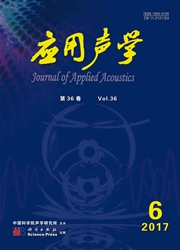

 中文摘要:
中文摘要:
接收球半径是采用声线跟踪法进行声场预测的一个重要参数。以前所用到的接收球半径一般是通过经验估计得到的,缺乏详细的理论分析。本文从声波传播机理角度分析了根据声线密度来确定接收球半径的原因,并推导了矩形闭空间中声线密度和接收球半径的计算方法。声线密度可以通过原始声线数目,声场空间体积与形状,边界吸声系数来确定。在一给定闭空间里,声线密度可看作是均匀分布的,所以接收球半径与空间位置无关,可看作是一个常数。但对不同的声场空间来说,由于空间体积、形状和吸声系数的变化,声线密度是不同的,因此接收球半径也会不同。声线密度越大,接收球半径越小;声线密度越小,接收球半径越大。实验表明,所提出的接收球模型能用来较准确地预测闭空间里的声压级和混响时间等声学参数。
 英文摘要:
英文摘要:
The receiving radius is an important parameter in ray-tracing sound prediction, whose value has often been estimated in empirical ways due to the lack of theoretical basis. This paper analyzes the reason that the receiving radius is determined by the sound ray density, and derives a formula for calculating the radius of the receiving sphere in rectangular enclosures. The sound ray density can be determined by the initial sound ray number, the volume and shape of the sound field, and the absorption coefficient of the boundaries.In an established enclosed sound field, the sound ray can be regarded as being distributed evenly, so that the receiving radius does not vary with the receiving position and is a constant. However, for different sound fields, because of the difference in the space volume, shape and absorption coefficient, the receiving radius are different. The greater is the sound ray density, the less is the receiving radius; the less is the sound ray density, the greater is the receiving radius. Experimental results validate that our proposed method for calculating the receiving radius can be used to predict some acoustical indexes such as the sound pressure level and the reverberation time in an enclosure.
 同期刊论文项目
同期刊论文项目
 同项目期刊论文
同项目期刊论文
 Experimental demonstration of electromagnetic tunneling through an epsilon near zero metamaterial at
Experimental demonstration of electromagnetic tunneling through an epsilon near zero metamaterial at Realization of a super waveguide for high-power density generation and transmission using right- and
Realization of a super waveguide for high-power density generation and transmission using right- and Sensor number requirements for sound power prediction using two different mode decomposition methods
Sensor number requirements for sound power prediction using two different mode decomposition methods 期刊信息
期刊信息
